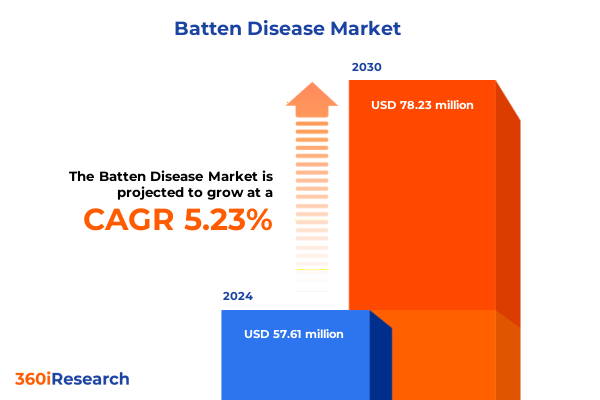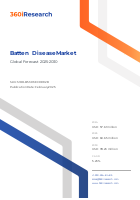The Batten Disease Market size was estimated at USD 57.61 million in 2024 and expected to reach USD 60.65 million in 2025, at a CAGR 5.23% to reach USD 78.23 million by 2030.

Introduction to the Batten Disease Therapeutic Landscape
Batten disease, a cluster of fatal pediatric neurodegenerative disorders known as neuronal ceroid lipofuscinoses (NCLs), presents significant challenges for patients, families and healthcare systems. Characterized by progressive vision loss, motor dysfunction and cognitive decline, these disorders impose an urgent need for innovative therapeutic strategies. Over the past decade, breakthroughs in molecular biology and gene therapy have reshaped the treatment paradigm, catalyzing a surge of clinical development activity and diverse treatment modalities.
This executive summary offers a concise yet comprehensive overview of the current Batten disease landscape. It explores transformative shifts in therapeutic approaches, examines the implications of evolving trade policies and delivers critical segmentation, regional and company insights. By synthesizing these perspectives, decision-makers will gain a strategic foundation to guide investment, research collaborations and policy advocacy as they navigate an increasingly dynamic Batten disease market.
Transformative Shifts in the Batten Disease Market Dynamics
In recent years, the Batten disease arena has experienced transformative shifts that redefine both clinical and commercial prospects. Breakthrough approvals of gene therapies targeting CLN subtypes have validated the potential for one-time interventions to arrest disease progression, while advances in small molecule drugs and enzyme replacement approaches continue to broaden the therapeutic arsenal. Moreover, the integration of real-world evidence and digital health platforms has accelerated patient identification and trial enrollment, addressing a long-standing bottleneck in rare disease research.
Public–private partnerships have emerged as a cornerstone of innovation, with patient advocacy networks funding translational studies and regulatory bodies offering expedited pathways for orphan indications. Concurrently, novel diagnostic tools-ranging from next-generation genetic testing to high-resolution MRI protocols-are enabling earlier detection and more precise phenotype stratification. These developments, coupled with increased philanthropic and venture capital funding, have shifted the landscape from incremental symptomatic management toward targeted, mechanism-based interventions.
Cumulative Impact of United States Tariffs 2025 on Batten Disease Treatments
As of 2025, new United States tariffs on imported active pharmaceutical ingredients and biologic components have introduced significant cost pressures across the Batten disease supply chain. Duties ranging from 10 to 25 percent on key raw materials sourced from major exporters have elevated manufacturing expenses for both small molecule and biologic therapies. In addition, tariffs on delivery devices and specialty packaging have compounded overall unit costs, compelling companies to reassess pricing strategies and margin forecasts.
Consequently, several therapeutics developers are exploring localized production capabilities to mitigate tariff exposure, while supply agreements are being renegotiated to secure favorable terms. Clinical trial sponsors have also encountered delays in shipping investigational materials, prompting contingency planning and increased buffer inventories. Despite these challenges, Section 301 exclusions and USMCA-related benefits offer partial relief for North American operations, incentivizing greater regional sourcing and supply chain diversification. Ultimately, the 2025 tariff landscape underscores the need for proactive financial planning and strategic procurement to sustain momentum in Batten disease research and development.
Key Segmentation Insights in the Batten Disease Therapeutic Market
The Batten disease therapeutic market is systematically studied across multiple dimensions to capture nuances in clinical development and commercial adoption. Based on disease type, research is concentrated on infantile NCL subtypes that account for early-onset presentations, guiding both trial designs and regulatory submissions. Treatment modalities range from traditional antibiotic therapy for secondary infections to cutting-edge enzyme replacement and gene therapies, as well as emerging small molecule drugs and stem cell approaches.
Drug classifications span FDA-approved products, off-label prescriptions and orphan drug candidates, reflecting diverse regulatory pathways. Patient demographics encompass the full pediatric spectrum-newborns, infants, toddlers, preschool children and adolescents-while care settings vary from home care protocols to hospital inpatient treatments, rehabilitation centers and specialized clinics. Research and development stages are tracked from preclinical studies through Phase I, Phase II and Phase III trials, with parallel emphasis on occupational, physical and speech therapy as supportive interventions.
Diagnostic strategies leverage EEG monitoring, comprehensive genetic testing and advanced MRI imaging to refine patient selection and monitor therapeutic response. End-users comprise biotechnology innovators, hospital systems and research institutes, operating alongside market players such as contract research organizations and large pharmaceutical companies. Product portfolios are categorized into biologics, biosimilars and recombinant proteins, each distributed through hospital pharmacies, online pharmacy platforms and traditional retail pharmacies. Finally, awareness programs-including healthcare provider training seminars, media outreach campaigns and patient advocacy initiatives-ensure that key stakeholders remain engaged and informed.
This comprehensive research report categorizes the Batten Disease market into clearly defined segments, providing a detailed analysis of emerging trends and precise revenue forecasts to support strategic decision-making.
- Disease Type
- Treatment Modality
- Drug Type
- Patient Demographics
- Care Setting
- Research & Development Stage
- Supportive Therapies
- Diagnostic Tools
- End-User
- Market Players
- Product Type
- Distribution Channels
- Awareness Programs
Geographic Variations and Regional Insights for Batten Disease
Regional dynamics play a pivotal role in shaping access, innovation and reimbursement for Batten disease therapies. In the Americas, the United States and Canada benefit from robust R&D ecosystems, well-established Orphan Drug incentives and comprehensive patient registries that accelerate trial recruitment. Health systems in Latin America are progressively adopting rare disease policies, though reimbursement pathways remain heterogeneous.
Across Europe, Middle East & Africa, the European Union leads in gene therapy approvals and collaborative consortia funding transnational trials, while Middle Eastern healthcare authorities are expanding rare disease frameworks. African markets continue to develop infrastructure, with select programs supported by global health organizations aimed at diagnostic capacity building.
The Asia-Pacific region has seen increasing public and private investment in rare disease research, particularly in Japan, Australia and South Korea, where regulatory agencies are streamlining orphan drug designations. Emerging economies such as China and India are ramping up clinical trial activity and forging local partnerships to bolster manufacturing capabilities. Digital distribution channels and e-pharmacies further enhance access in remote areas, complementing traditional hospital and retail pharmacy networks.
This comprehensive research report examines key regions that drive the evolution of the Batten Disease market, offering deep insights into regional trends, growth factors, and industry developments that are influencing market performance.
- Americas
- Asia-Pacific
- Europe, Middle East & Africa
Strategic Moves by Leading Companies in the Batten Disease Arena
Leading players are driving innovation through diverse portfolios and strategic collaborations. Abeona Therapeutics is advancing AAV-based gene therapies targeting CLN3 and CLN6 mutations, building on promising preclinical data. Alexion Pharmaceuticals is enhancing central nervous system delivery of enzyme replacement therapies to improve efficacy and durability. Amicus Therapeutics specializes in small molecule chaperones designed to stabilize misfolded proteins, offering oral administration advantages.
BioMarin Pharmaceutical has established a market presence with FDA-approved enzyme replacement agents and is expanding into gene editing approaches. Denali Therapeutics leverages proprietary transport vehicles to cross the blood–brain barrier, targeting lysosomal dysfunction at the molecular level. Neurogene Inc. focuses on novel viral vectors engineered for enhanced tropism in neural tissues.
Global pharmaceutical giant Novartis applies its platform technologies across multiple CLN subtypes, while Orchard Therapeutics pursues ex vivo gene therapies with autologous stem cell delivery. Passage Bio Inc. explores next-generation capsid variants for improved transduction efficiency, and Regenxbio Inc. optimizes large-scale vector manufacturing processes. Teva Pharmaceuticals Industries integrates repurposed small molecules with supportive care frameworks, reinforcing a holistic patient management strategy.
This comprehensive research report delivers an in-depth overview of the principal market players in the Batten Disease market, evaluating their market share, strategic initiatives, and competitive positioning to illuminate the factors shaping the competitive landscape.
- Abeona Therapeutics Inc.
- Alexion Pharmaceuticals Inc.
- Amicus Therapeutics
- BioMarin Pharmaceutical Inc.
- Denali Therapeutics
- Neurogene Inc.
- Novartis AG
- Orchard Therapeutics
- Passage Bio, Inc.
- Regenxbio Inc.
- Teva Pharmaceuticals Industries Ltd.
Actionable Recommendations for Industry Leaders Addressing Batten Disease
To navigate the evolving Batten disease landscape, industry leaders should consider the following actionable steps. First, invest in regional manufacturing capabilities and strategic supplier partnerships to counterbalance tariff-driven cost increases and reduce lead times. Second, accelerate diagnostic adoption by integrating next-generation genetic testing and advanced imaging protocols into standard care pathways, thereby enabling earlier intervention.
Third, deepen engagement with patient advocacy organizations and healthcare provider networks through targeted educational initiatives and collaborative research grants. Fourth, expand real-world evidence platforms to generate longitudinal data on safety, efficacy and quality of life, strengthening value propositions for payers and regulators. Fifth, diversify pipelines to include both platform-based gene therapies and complementary small molecule or enzyme replacement modalities, mitigating program-specific risk.
Sixth, reinforce supply chain resilience by implementing multi-source procurement strategies, inventory buffers and digital tracking systems. Seventh, liaise proactively with regulatory authorities to streamline rare disease trial designs and accelerated approval mechanisms. Eighth, leverage digital health tools-such as remote monitoring apps and telemedicine consultations-to maintain patient engagement and adherence. Finally, foster cross-sector alliances spanning biotechnology, academia and government to unlock new funding, shared infrastructure and translational expertise.
Explore AI-driven insights for the Batten Disease market with ResearchAI on our online platform, providing deeper, data-backed market analysis.
Ask ResearchAI anything
World's First Innovative Al for Market Research
Conclusion: Charting the Future of Batten Disease Therapeutics
The Batten disease therapeutic landscape is at a pivotal juncture, marked by scientific breakthroughs, evolving trade policies and intensified competition. Stakeholders who embrace a holistic strategy-integrating localized manufacturing, advanced diagnostics, stakeholder alignment and regulatory agility-will be best positioned to deliver life-changing therapies to patients.
Success will depend on balancing innovation with operational excellence, leveraging both platform technologies and complementary modalities to address diverse NCL subtypes. Cultivating robust partnerships across the healthcare ecosystem-engaging patient groups, payers, providers and policymakers-will further ensure that novel treatments reach those in need without undue delay. Ultimately, sustained momentum in Batten disease research and commercialization demands strategic foresight, disciplined investment and unwavering commitment to patient outcomes.
This section provides a structured overview of the report, outlining key chapters and topics covered for easy reference in our Batten Disease market comprehensive research report.
- Preface
- Research Methodology
- Executive Summary
- Market Overview
- Market Dynamics
- Market Insights
- Cumulative Impact of United States Tariffs 2025
- Batten Disease Market, by Disease Type
- Batten Disease Market, by Treatment Modality
- Batten Disease Market, by Drug Type
- Batten Disease Market, by Patient Demographics
- Batten Disease Market, by Care Setting
- Batten Disease Market, by Research & Development Stage
- Batten Disease Market, by Supportive Therapies
- Batten Disease Market, by Diagnostic Tools
- Batten Disease Market, by End-User
- Batten Disease Market, by Market Players
- Batten Disease Market, by Product Type
- Batten Disease Market, by Distribution Channels
- Batten Disease Market, by Awareness Programs
- Americas Batten Disease Market
- Asia-Pacific Batten Disease Market
- Europe, Middle East & Africa Batten Disease Market
- Competitive Landscape
- ResearchAI
- ResearchStatistics
- ResearchContacts
- ResearchArticles
- Appendix
- List of Figures [Total: 42]
- List of Tables [Total: 600 ]
Next Steps: Secure Your In-Depth Batten Disease Market Report Today
Ready to gain an in-depth understanding of the Batten disease market and inform your strategic decisions? Contact Ketan Rohom (Associate Director, Sales & Marketing at 360iResearch) to purchase the comprehensive market research report and unlock the full spectrum of insights, data and expert analysis essential for driving growth in this dynamic field.

- How big is the Batten Disease Market?
- What is the Batten Disease Market growth?
- When do I get the report?
- In what format does this report get delivered to me?
- How long has 360iResearch been around?
- What if I have a question about your reports?
- Can I share this report with my team?
- Can I use your research in my presentation?




